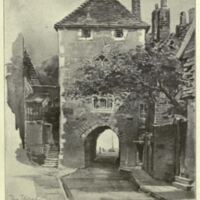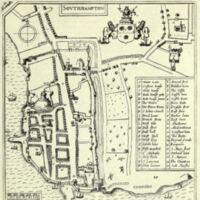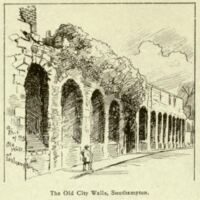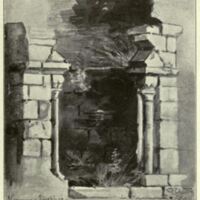Subject
Mackennel begins his chapter on the Mayfower and Southampton by considering the tension between the development of the modern city and the wish to preserve notable historical buildings. This tension between the old and new can be felt in much of the Homes and Haunts of the Pilgrim Fathers where industrial landscapes come face to face with rural England and the buildings of the seventeenth-century. Mackennel also notes the conjecture that underlines Southampton’s connection to the story of the Mayflower and its ladning in the city: “Tradition has it that it was at the West Quay the Mayflower lay […] [w]e could, however, wish that there were more certainty about the whole matter”. Despite this guesswork and supposition that is part of Southampton would place a central role in the 1920 Mayflower tercentenary celebrations.
“The lot of an enlightened modern alderman in one of these old towns is not always happy; he is ever being scolded and pulled hither and thither by opposite factions. The earnest social reformer says: ' My dear sir, those narrow streets and courts of yours are a disgrace; the overcrowding in these low-pitched rooms which have stood unaltered since good Queen Bess's time, is abominably insanitary. Pull the whole lot down, sir, widen the street, and build a modern block of artisans' dwellings on that ancient site.' The cultured antiquarian and lover of the picturesque breathes threats and scorn at the said alderman's mildest suggestion to move one single stone: ' Touch not the ancient landmarks; remove thy interfering hand from the venerable pile.' The alderman has to hear all this, or something like it, continuously; and it says much for the wisdom of the corporation of this quaint old town, that they have brought their old Saxon, then Norman, wall-entrenched city right up to the days of the twentieth century, without either calamity on the one side, or needless, ruthless desecration on the other.
These thoughts came to our mind as we walked along the front on the newly made Corporation Road, and noticed with what care all the old city walls had been preserved, and only where it was absolutely necessary had they repaired or pointed, and nowhere, as far as we could see, had they put new work on to old. So when at last we got actually to the West Quay, we felt certain that what met our eyes had also certainly met those of the Pilgrim Fathers, who had to wait weary days here on board the Mayflower. In our reproduction of the old 1611 map of Southampton, it is the only part of the water-side which has a true quay at all; for a quay, it must be remembered, is an artificial landing-place or stage, built out, and not the natural boundary of land and water.
Tradition has it that it was at the West Quay the Mayflower lay. And even if there had been no tradition to guide us, we should have selected this spot, as it is clearly one of the old quiet corners of the place, and not too near the official and military side.
It is not known how long they stayed at Plymouth, or even exactly when the Pilgrim Fathers arrived there; but the date of their arrival at Southampton is fixed and certain. On July 22, 1620, the Speedwell and the Mayflower both arrived, and there they remained till the afternoon of August 5, when they turned away once again to sea. These poor voyagers waited and watched exactly fourteen days, and we can easily picture them walking up and down on the quay, or strolling into the town under one or other of the massive gateways that remain to this day, to get their last peeps at the busy streets and bright shops and stalls sights which they knew full well they would never again see after they had emigrated to the new and lonely land.
"Some authorities have urged that both ships lay near what is called the Platform an open space on which certain cannon then, as now, were mounted ; and in one early history of the Pilgrim Fathers, published in London, we remember seeing a picture of this very spot shown as the place; but no historic authority was given for the assertion. The old 1611 map, which we reproduce, materially helps us. If there had been no other quay or place where they could have moored, they would probably have had to lay near the Platform ; but as we now see by this map there was at this date a convenient spot a little farther up the Water, we may be sure they would go there, rather than moor their vessels amidst the military and official life that would crowd and jostle by the Water Gate.
We could, however, wish that there were more certainty about the whole matter, but no stone tablet can here mark the spot, as it is marked farther along the coast in Devonshire's beautiful port of Plymouth; and we can only suggest that there is useful and needed investigation open to some local antiquarian in this question of solving exactly where the first American liner lay in the Port of Southampton.”




